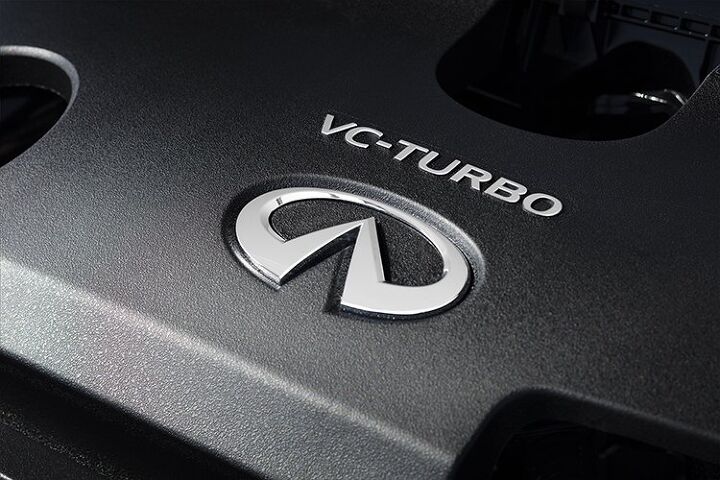Infiniti Wasn't Fibbing When It Estimated the Revolutionary QX50 Engine's Thirst

One thing is clear — with variable compression comes a newfound lack of thirst.
Infiniti’s previous midsize QX50 crossover didn’t astound in its thrift, garnering 20 miles per gallon on the EPA combined cycle. The move to a new, front-drive platform and addition of a years-in-the-making gasoline engine for 2019 has done wonders for the model’s drinking habit, however, and Infiniti engineers pegged the MPG figures right on the nose.
With the 2019 QX50‘s fuel economy now confirmed by the EPA, it begs the question: just how much of the model’s thriftiness can the variable compression engine take credit for?
By adopting a turbocharged 2.0-liter four-cylinder with revolutionary internals, the front-drive 2019 QX50 delivers 27 mpg combined, 24 in the city, and 31 on the highway. Shave off 1 mpg from the highway and combined figures for the all-wheel-drive model.
This is exactly the estimated 35 percent (FWD) and 30 percent (AWD) increase in fuel economy touted by Infiniti reps at a recent first drive event. Last year, chief powertrain engineer Shinichi Kiga said the VC-T engine would help the new QX50 top the old one by 27 percent on the combined cycle.
To put the mileage into perspective, Acura’s MDX Sport Hybrid, available only in AWD, rates 27 mpg on the combined cycle. But the Infiniti, devoid of any pricey electrical trappings, beats it by 3 mpg on the highway.
It would be interesting — and informative — to see an engine swap performed on an existing model, with no other changes. That’s because, for 2019, the QX50 donned more than just a new skin and beating heart. Its engine went from a 3.7-liter naturally aspirated V6 to a turbocharged four-banger designed to make up for the lost displacement with varying piston reach. Horsepower shrunk from 325 to 268, with torque seeing a boost from 267 to 280 lb-ft.
While engineers shaved some weight from the new model, the lost heft didn’t amount to more than 100 pounds. The previous seven-speed automatic transmission also disappeared in favor of a continually variable unit programmed with economy in mind. It’s no secret CVTs are the go-to ‘box for ultra-thrifty models, but combined MPG gains well into the double digits are not something you’ll attain with a simple tranny swap.
In the absence of significant lightweighting, the new engine looks to be the main culprit. It’s certainly a win for Infiniti engineers and the brand itself, but it remains to be seen if the new engine (and styling) helps win the QX50 more fans than the previous-generation model, which never became a huge player in the all-important premium crossover segment.
As for reliability, we can only trust Infiniti did its homework there, too.
[Images: Infiniti]

More by Steph Willems
Latest Car Reviews
Read moreLatest Product Reviews
Read moreRecent Comments
- MaintenanceCosts I wish more vehicles in our market would be at or under 70" wide. Narrowness makes everything easier in the city.
- El scotto They should be supping with a very, very long spoon.
- El scotto [list=1][*]Please make an EV that's not butt-ugly. Not Jaguar gorgeous but Buick handsome will do.[/*][*] For all the golf cart dudes: A Tesla S in Plaid mode will be the fastest ride you'll ever take.[/*][*]We have actual EV owners posting on here. Just calmly stated facts and real world experience. This always seems to bring out those who would argue math.[/*][/list=1]For some people an EV will never do, too far out in the country, taking trips where an EV will need recharged, etc. If you own a home and can charge overnight an EV makes perfect sense. You're refueling while you're sleeping.My condo association is allowing owners to install chargers. You have to pay all of the owners of the parking spaces the new electric service will cross. Suggested fee is 100$ and the one getting a charger pays all the legal and filing fees. I held out for a bottle of 30 year old single malt.Perhaps high end apartments will feature reserved parking spaces with chargers in the future. Until then non home owners are relying on public charge and one of my neighbors is in IT and he charges at work. It's call a perk.I don't see company owned delivery vehicles that are EV's. The USPS and the smiley boxes should be the 1st to do this. Nor are any of our mega car dealerships doing this and but of course advertising this fact.I think a great many of the EV haters haven't came to the self-actualization that no one really cares what you drive. I can respect and appreciate what you drive but if I was pushed to answer, no I really don't care what you drive. Before everyone goes into umbrage over my last sentence, I still like cars. Especially yours.I have heated tiles in my bathroom and my kitchen. The two places you're most likely to be barefoot. An EV may fall into to the one less thing to mess with for many people.Macallan for those who were wondering.
- EBFlex The way things look in the next 5-10 years no. There are no breakthroughs in battery technology coming, the charging infrastructure is essentially nonexistent, and the price of entry is still way too high.As soon as an EV can meet the bar set by ICE in range, refueling times, and price it will take off.
- Jalop1991 Way to bury the lead. "Toyota to offer two EVs in the states"!



































Comments
Join the conversation
The MDX hybrid is geared toward performance over outright fuel economy. It's also bigger and heavier. The Lexus RX 450h is closer and rates 30 mpg combined.
Nightmare engine guts, unproven durability plus CVT? Nissan?! The only way for that combination to be worse is substitute "Nissan" with something German. A neat experiment, but I feel long term reliability is questionable.